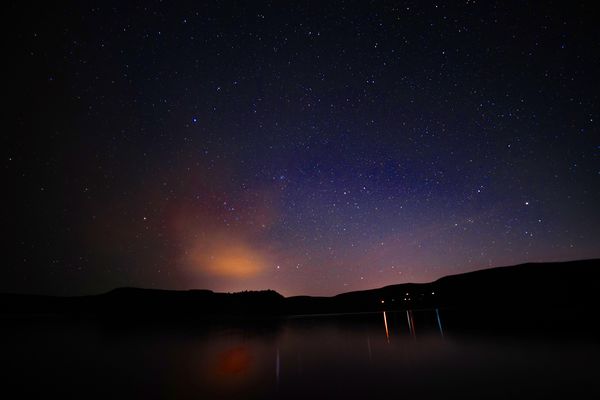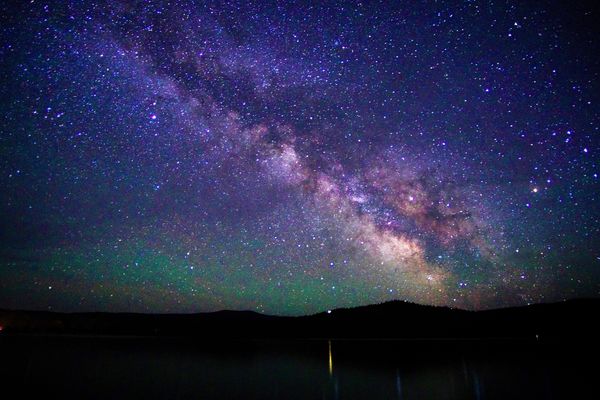Live view question
May 7, 2019 12:11:46 #
I just bought a used (but new to me) D7000. Yeah, the original 7000. Dual card slots, incredible battery life (rated at 1100 shots per charge per Nikon), top LCD panel, really bright 100% optical viewfinder. Picked it up for $279US. Has 5k clicks. I know I'll put at least that many on in the coming 6 months. I have two lenses - 18-55 mm VR II DX ED and a 35mm 1.8. Yeah, just two lenses. So many buttons. No digging through menus.
So I went out last night to try to get some night sky photos. Previously, I've been using my Nikon 1 J5 for astrophotography, so I knew ahead suggested ISO, shutter, aperture, etc. No VR, all manual (duh).
Couldn't see much through the optical viewfinder, so I switched to Live view. Nothing on the screen. Thought I left the lens cap on. Nope, lens cap was in my pocket. Wished for the best and clicked the ML-L3 remote. Previewed the photo and it came out fine.
I'm asking here because I might get some unbiased, knowledgeable feedback and Google searching is useless.
So is live view broken? Works just fine in daytime. Maybe it was past its bedtime? I thought live view would help me but its not. The LCD monitor brightness was at 0, maybe I should've cranked it up to +3 max? Would it help if I hit the reset all menu? Maybe I screwed up something somewhere. Very possible. Man, so many menus...
So I went out last night to try to get some night sky photos. Previously, I've been using my Nikon 1 J5 for astrophotography, so I knew ahead suggested ISO, shutter, aperture, etc. No VR, all manual (duh).
Couldn't see much through the optical viewfinder, so I switched to Live view. Nothing on the screen. Thought I left the lens cap on. Nope, lens cap was in my pocket. Wished for the best and clicked the ML-L3 remote. Previewed the photo and it came out fine.
I'm asking here because I might get some unbiased, knowledgeable feedback and Google searching is useless.
So is live view broken? Works just fine in daytime. Maybe it was past its bedtime? I thought live view would help me but its not. The LCD monitor brightness was at 0, maybe I should've cranked it up to +3 max? Would it help if I hit the reset all menu? Maybe I screwed up something somewhere. Very possible. Man, so many menus...
May 7, 2019 12:21:30 #
I'm thinking there was not enough light to show up on the live view. You could test it by holding a match up in front of the lens while in live view.
May 7, 2019 12:25:35 #
tom hughes
Loc: Phila Pa
Take your camera out back on a dark night. Switch on live view. Take a flashlight and illuminate an object. Viola, then use your magnification and focus the object. Turn off ,live view, and take your photo. If there is no illumination live view at night ,will view nothing.
May 7, 2019 12:27:19 #
Your live view is ok. It is just that there isn’t enough light for the live view and optical viewfinder to see. I have a Sony a7s that is renound for its high ISO low light ability’s. In order to see in live view I have to crank up the ISO to max that’s over 128000. But I shoot the photo at ISO 3200, 20sec exp. f2.8. Live view just doesn’t take in account for your long exposure. If it works by day. It’s working at night. At night most cameras become “point and shoot”. Re-adjust. Point and shoot, and do it again. That’s just the way it is.
25sec ISO 3200 f2.8

May 7, 2019 13:14:19 #
Jbrustrom wrote:
I just bought a used (but new to me) D7000. Yeah, ... (show quote)
Live view can just show what's in front of the lens, and if there was just a dark/black sky, that's what the screen shows!
May 7, 2019 13:22:47 #
If I take a test shot at ISO 6400, how long should it be? 4 sec? And the real shot at ISO 800, maybe 30 sec?
Trying to set different ISOs in the dark is going to be a pita. Can I set U1 for the test shot and U2 for the final? Then I have only one dial to switch.
Trying to set different ISOs in the dark is going to be a pita. Can I set U1 for the test shot and U2 for the final? Then I have only one dial to switch.
May 7, 2019 15:16:38 #
Jbrustrom wrote:
If I take a test shot at ISO 6400, how long should it be? 4 sec? And the real shot at ISO 800, maybe 30 sec?
Trying to set different ISOs in the dark is going to be a pita. Can I set U1 for the test shot and U2 for the final? Then I have only one dial to switch.
Trying to set different ISOs in the dark is going to be a pita. Can I set U1 for the test shot and U2 for the final? Then I have only one dial to switch.
You didn't state your f-stop. The difference between ISO3200 and 6400 is only 1 f-stop. If you were shooting f-2.8 the shutter speed would be 10 sec. But more likely 15 sec. Note: there are also factors in the camera program for long exposures. Sort of like figuring in receseprocity factor in film.Yes it take a lot of wasted shots to figure out night shots but you're not burning up a roll of 36 exp film and waiting a week for the results either.
ISO 4000, 25sec, f-2.8

May 8, 2019 04:23:54 #
May 8, 2019 10:43:00 #
Using the 35 mm, I'd be shooting wide open at f 1.8 for the greatest amount of light. Using the 18-55 mm, I'd be shooting at f 3.5 for a test shot, then maybe stopping down to f 5.0 or not.
May 8, 2019 12:00:17 #
tradio wrote:
I shoot at 100 ISO and vary the time as needed.
You shoot star shots at ISO 100. Your exposure must be minutes long.
May 8, 2019 12:11:14 #
Use the 500 rule. Divide the focal length of your lens into 500 and that gives you the longest exposure you can have without star trails. Example: I shoot full frame 14mm wultra wide lens. 500 divided be 14 = 35.7. So the longest exposure I can use without getting apparent star trails is 35 seconds. If your shooting APS-c then you have to first multiply the focal length by 1.5 then divide that into 500. Example: 35 x 1.5 = 52.5 then 500 divided by 52.5 = 9.5 So 9 seconds would be your longest exposure you could use without star trails. Good luck
May 9, 2019 10:18:50 #
May 10, 2019 23:40:55 #
kb6kgx
Loc: Simi Valley, CA
ORpilot wrote:
You shoot star shots at ISO 100. Your exposure must be minutes long.
Although it has been about 40 years since I last tried taking star photos, I found that at about 30 seconds of exposure, you start to get star “trails”.
May 12, 2019 14:55:52 #
If you want to reply, then register here. Registration is free and your account is created instantly, so you can post right away.

